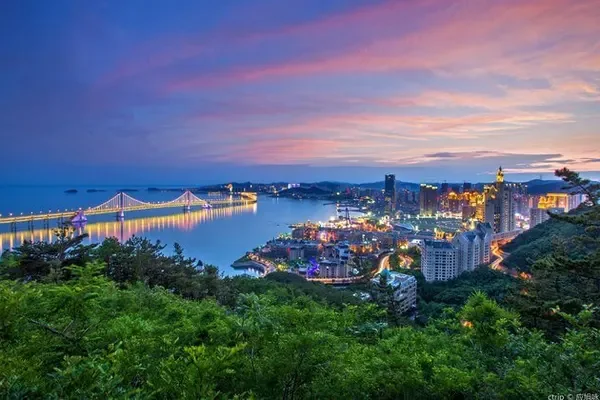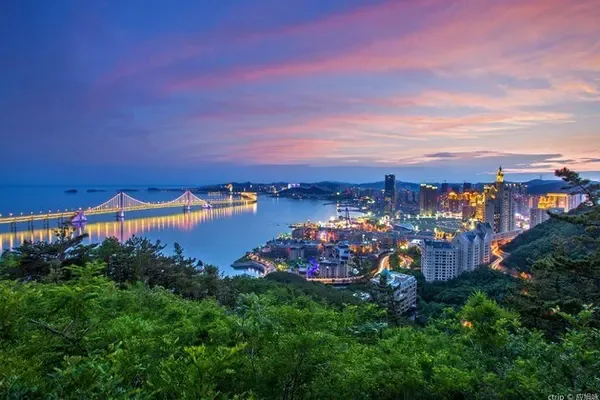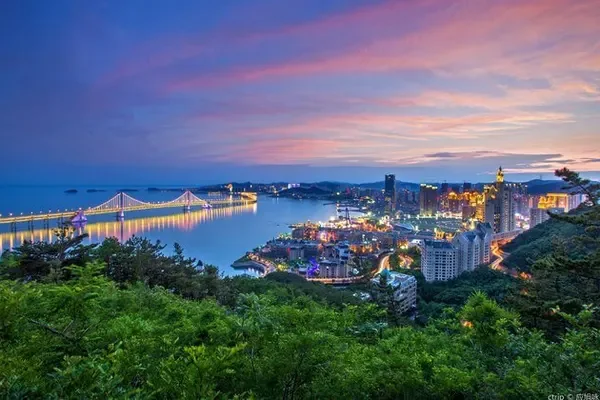Written on the front: Beijing, the capital of the country, is a sacred, majestic and magnificent city. The Tiananmen Gate Tower and the mottled bricks and tiles of the Forbidden City narrate the changes of the Ming and Qing Dynasties. The magnificence of the Summer Palace and the broken walls of the Old Summer Palace silently reflect the every move of the Chinese people in that period. While giving nourishment to history, we should also call for more people with lofty ideals and learning to remember the ruins of the Old Summer Palace and the hardships of the founding of New China, remember the past and open up the future, and inject our own part into the realization of the Chinese dream. Power source.
This time I travel on my own, and the itinerary is about 6 days. Due to the summer vacation, the cost has increased slightly. Through my own "calculation and careful planning", I try to travel frugally without losing the petty bourgeois sentiment. The per capita cost is about ¥ 5000, the following is the itinerary for your reference:
Day1: Arrive in Beijing by night plane - Morning: Watch the Tiananmen Square Flag Raising Ceremony in the morning, Tiananmen Square (National Museum, Monument to the People's Heroes, Great Hall of the People) - Lunch: Homestay Rest - Evening: Deyun Society
Food: Huguo Temple snacks, Hunan restaurant, Dahai Bowl
Day2: Morning & Lunch: Palace Museum (Treasure Hall, Clock Hall) - Evening: Wangfujing
Food: Jiahe Yipin, dry food for lunch, Four Seasons Minfu
Day3: Morning & Afternoon: Jiayuguan Great Wall - Evening: Bird's Nest Water Cube
Food: Jiahe Yipin, Youshunju Restaurant, quinoa porridge in a small bowl
Day4: Early: Summer Palace - Lunch: Tsinghua University, Yuanmingyuan - Evening: Rest
Food: Jiahe Yipin, Xijiade Shrimp Dumplings, Northeast Bone Pot
Day5: Morning: Temple of Heaven Park - Lunch: Bell Tower and Drum Tower, Yandai Xiejie, Lama Temple, Guijie Street - Evening: Nanluoguxiang, Shichahai
Food: Jiahe Yipin, Donglaishun Restaurant, Huda Restaurant
Day6: Early: Military Museum - Lunch: Prince Kung's Mansion - Return to Guangzhou by night flight
Happy journey is over~~~~
Transportation: Beijing Subway, Bus, Day Tour Bus, Airplane
Accommodation: homestay
Day1: Arrive in Beijing by night plane - Morning: Watch the Tiananmen Square Flag Raising Ceremony in the morning, Tiananmen Square (National Museum, Monument to the People's Heroes, Great Hall of the People) - Lunch: Homestay Rest - Evening: Deyun Society
Food: Huguo Temple snacks, Hunan restaurant, Dahai Bowl
Arriving in Beijing on the first day, the itinerary was rather exhausting. After the night flight arrives, take a short break, and leave for Tiananmen Square at around 3:30 to watch the flag raising. There are so many spectators, the scene is relatively crowded, and the waiting time is also very painful. When it sounded, I was quite shocked in my heart. It is absolutely worthwhile to come and see it!





In front of the Tiananmen Gate Tower, witnessing the morning line approaching step by step, Xiaguang climbed up the gate tower bit by bit. Standing motionless against our guards, the stern integrity and professionalism of the soldiers are admirable. The national flag is raised, the national anthem is played, and the softest part of everyone's heart is hit, and the pride allows themselves to blend with the national anthem and rise to the top together.
After the flag-raising ceremony, we went to the nearby Huguo Temple snacks to taste Beijing-style specialties such as old Beijing fried noodles, donkey rolling, and pea yellow. Although they are foreign dishes, they have a unique flavor.
After a brief supplement, we returned to Tiananmen Square to continue our tour. First of all, we came to the Monument to the People's Heroes to admire the deeds of the martyrs and feel the influence of revolutionary culture.


Come to the National Museum located on the southeast side of Tiananmen Square (the museum is best to make an appointment in advance to avoid long queues), there are more than a thousand "heavy weapons of the country" on display. Rare and rare treasures are exquisitely crafted, condensing the crystallization of the knowledge and craftsmanship of the Chinese nation for thousands of years.









Due to the limited visiting time and the enormous size of the venue, the author could only take a quick look at the flowers and eat them all. After a brief look at the Ancient China Pavilion, he reluctantly left. Friends who are interested and have time can continue to visit in depth, I believe they will gain a lot.
After having a meal at a Hunan restaurant at noon, I went to book a B&B to check in and take a short rest to relieve the fatigue of the first day. After resting for an afternoon, we went to the Dahai Bowl near Deyun Club for dinner, and experienced Beijing-style cross talk and Beijing-style humor at Deyun Club. The entire decoration of Deyun Club also has an old Beijing flavor. The Beijing dialect, which is so fast, is a favorite of Beijing-style humor, and we have also gained a lot.




Day2: Morning & Lunch: Palace Museum (Treasure Hall, Clock Hall) - Evening: Wangfujing
Food: Jiahe Yipin, dry food for lunch, Four Seasons Minfu
After breakfast, we went to the largest museum in Beijing - the Palace Museum for a nearly one-day visit. This journey is destined to be very meaningful.



Founded in 1925, the Palace Museum is built on the basis of the Forbidden City, the imperial palace of the Ming and Qing dynasties. After five hundred years of ups and downs, the gates of the imperial palace are finally open to the public. The Palace Museum is the largest and best-preserved wooden palace complex in the world. It is the pride of the Chinese nation and a precious cultural heritage of all mankind. Today, the 1.12 million square meters of palaces in the forbidden area of the former imperial palace are not only a huge treasure house for the treasures of the Ming and Qing royal families, but also a living archive recording the history of the Ming and Qing courts...





Tickets for the Forbidden City include two parts: the Treasure Hall and the Clock Hall. They are all exhibitions where rare treasures came to pay tribute to the dynasty. It is an eye-opening feast for the eyes.



























When I came to the back garden of the Forbidden City, despite the light rain, the enthusiasm for visiting remained undiminished, and the garden scenery became more beautiful and brighter.








The Forbidden City is Jingshan Park, the place where Emperor Chongzhen hanged himself, but now things are different, the sea is full of vicissitudes, white clouds and dogs, it is very emotional.
Hungry, we got up and went to Siji Minfu to have a big meal of Peking duck. Fortunately, we went early, otherwise we would have to wait in line!





This golden color is mouth-watering, and the index finger is moving. After the stormy meal, everyone was full of food and drink, full of energy, and came to Wangfujing Street for a night tour of Beijing Pedestrian Street.








Day3: Morning & Afternoon: Jiayuguan Great Wall - Evening: Bird's Nest Water Cube
Food: Jiahe Yipin, Youshunju Restaurant, quinoa porridge in a small bowl
The author of this day's itinerary chose to follow the local one-day tour tour group. The reason why I chose Jiayuguan is because I consider that during the summer vacation, the Badaling Great Wall is definitely to see people's heads, and I lack the interest to climb the Great Wall. As the saying goes, if you don’t reach the Great Wall, you are not a hero. How can you come to Beijing without climbing the Great Wall? It was also a beautiful day at that time, and it was rainy and cloudy that day. Although it was impossible to capture the magnificence and majesty of the Great Wall, it was definitely the best time to climb the Great Wall.











The longest part of the Great Wall is not the Great Wall that twists and turns, folds and rises, nor is it the Great Wall that winds back and forth, each embracing the terrain, but the Great Wall that is so foggy that it is impossible to see where the next step leads.
Due to limited time, the author can only climb from Beacon Tower No. 14 to No. 19-20, and then return the same way. The infinite scenery is on the dangerous peak. I hope other friends who have time will continue to persevere. Beacon Tower 22 is waiting for you!
After the tour of the Great Wall was over, we took the bus back to the urban area and visited the Bird's Nest Water Cube Olympic Village.








After having dinner in the small bowl of quinoa porridge in Xin'ao Shopping Center, when it gets dark, the night view of the Bird's Nest Water Cube is even brighter.







Day4: Early: Summer Palace - Lunch: Tsinghua University, Yuanmingyuan - Evening: Rest
Food: Jiahe Yipin, Xijiade Shrimp Dumplings, Northeast Bone Pot
On the fourth day, we visited 3 gardens in 1 day, including the Summer Palace, Tsinghua Garden, and Yuanmingyuan, and simply reached the goal of 3w steps (laughing and crying).
The Summer Palace is located in the northwest suburb of Beijing, mainly composed of Longevity Hill and Kunming Lake. As early as the Yuan and Ming Dynasties, it has become a famous tourist attraction with its beautiful and natural pastoral scenery as "the most spectacular in China". Today's Longevity Mountain was named Weng Mountain in the Yuan Dynasty. It is said that an old man dug out a stone urn full of treasures on the mountain and got its name. There is a lake named Wengshan Po in front of the mountain. Among them, the "Dachengtian Husheng Temple" on the north bank of the lake is the largest, with magnificent buildings and white marble fishing platforms extending into the lake. Emperors of the Yuan Dynasty often came here for boating and fishing. In the Ming Dynasty, Wengshan Po was renamed West Lake, "surrounding the lake for ten miles, it is a resort in a county". Every year when the willows are red and the willows are green, the people in the capital help the old and the young to go to the West Lake for an outing to enjoy the spring. The name is "playing with the scenery of the West Lake". At that time, people still had the reputation of "Ten Temples of West Lake" and "Ten Views of West Lake".
The Summer Palace was originally the palace and garden of the emperors of the Qing Dynasty. Its predecessor, Qingyi Garden, was the last garden built among the three mountains and five gardens. Before Qianlong succeeded to the throne, four large royal gardens had been built in the western suburbs of Beijing, from Haidian to Xiangshan. These four gardens form a self-contained system, lack of organic connection with each other, and the "Wengshan Po" in the middle has become an open area. In the fifteenth year of Qianlong's reign (1750), Emperor Qianlong rebuilt it into Qingyi Garden. With this as the center, the four gardens on both sides were connected into one, forming a 20-kilometer royal garden area from the current Qinghua Garden to Xiangshan. . In the tenth year of Xianfeng (1860), Qingyi Garden was burned down by the British and French allied forces. In the 14th year of Guangxu (1888), the Empress Dowager Cixi used 30 million taels of silver to rebuild it in the name of raising funds for the navy, and renamed it the Summer Palace as a summer playground.

















At the end of the trip to the Summer Palace, we enjoyed dumplings at the Xijiade Dumpling Shop, avoiding the scorching sun at noon, and then went to Tsinghua Garden to pay homage to the giants.
Tsinghua University is the highest university that most students dream of day and night, and it is a benchmark school for Chinese teaching. It is also built in the royal garden, and has a lot of historical precipitation (Tsinghua University and Peking University tickets must be reserved about 1 week in advance, do not Challenge the arm strength of the security guard)
We ran into a sophomore in the student union who was a campus guide for us. The senior talked about the school's development history and solid foundation, as if opening a pot of ancient tea, with a strong sweetness and a mellow aroma. I was deeply impressed by the grace, magnanimity, morality, talent and generosity of Tsinghua students, as well as the moonlight in the lotus pond in Tsinghua Garden.













After visiting Tsinghua University, we continued our journey to the Old Summer Palace, looking for cultural footprints in the ruins, and feeling the power of national rejuvenation.






















Feeling the message conveyed by the ruins, the history of the Chinese nation being trampled cannot be forgotten, and the path of the great rejuvenation of the Chinese nation must be followed more firmly and resolutely by us.
In the evening, I have a full meal at the northeast bone pot. The price of the store is very high, and the bone pot is very tasty. I highly recommend it!

Day5: Morning: Temple of Heaven Park - Lunch: Bell Tower and Drum Tower, Yandai Xiejie, Lama Temple, Guijie Street - Evening: Nanluoguxiang, Shichahai
Food: Jiahe Yipin, Donglaishun Restaurant, Huda Restaurant
After breakfast on the fifth day, proceed to the Temple of Heaven Park and visit the place where the emperor offered sacrifices to heaven.









After the visit, go to Gulou Street to brush the mutton, which is delicious~~


In the afternoon, we choose a large-scale scenic spot group tour method to visit multiple scenic spots in the Shichahai area to improve time utilization.



bell tower drum tower



Yandai Xiejie






Lama Temple



Gui Street

Nanluoguxiang




Shichahai Bar Street
This day is full and exciting, and it is of great reference value~
Attached below is the fried chicken delicacy tasted at Hu Da Restaurant, it is simply irresistible, and the index finger is moving~





Day6: Early: Military Museum - Lunch: Prince Kung's Mansion - Return to Guangzhou by night flight
This is the last day in Beijing, and the itinerary is relatively relaxed. We will see airplanes and cannons at the Military Museum, and see whether He Shen is a minister of the country or a villain at Prince Gong's Mansion.









In the afternoon, the trip to Prince Gong’s Mansion~~ (exposed to the sun)














The trip to Beijing has come to an end~~
Conclusion: The pilgrimage to Beijing, the accumulation of the capital's history can be said to be a quick review, and I hope readers will forgive me for the shortcomings. I hope you all take the time to come to the capital, immerse yourself in the historical precipitation, feel more the beauty of humanities, build a life for the people, inherit the unique knowledge of the saints, and create peace for all generations. This is what tourism in the capital should be.


